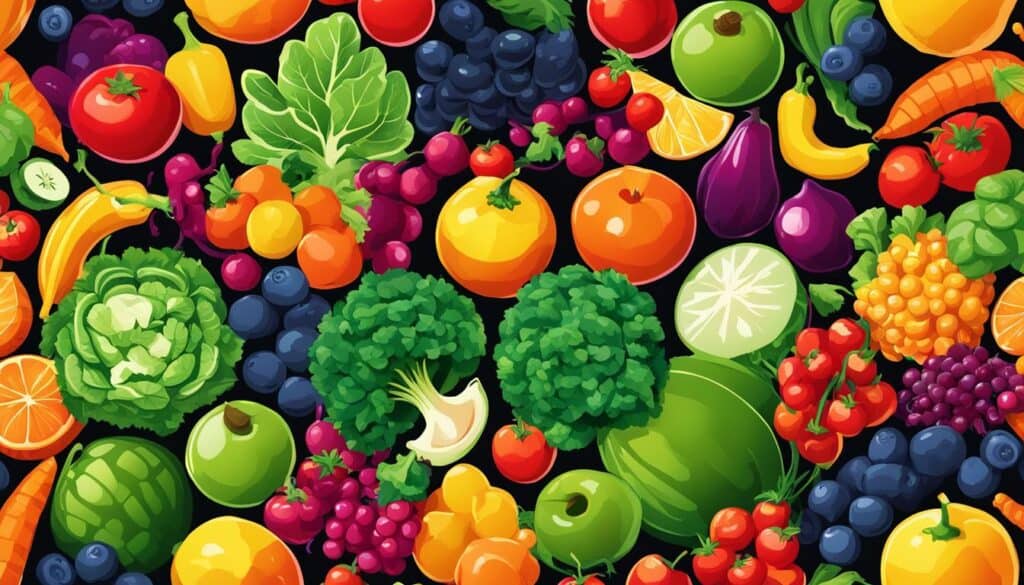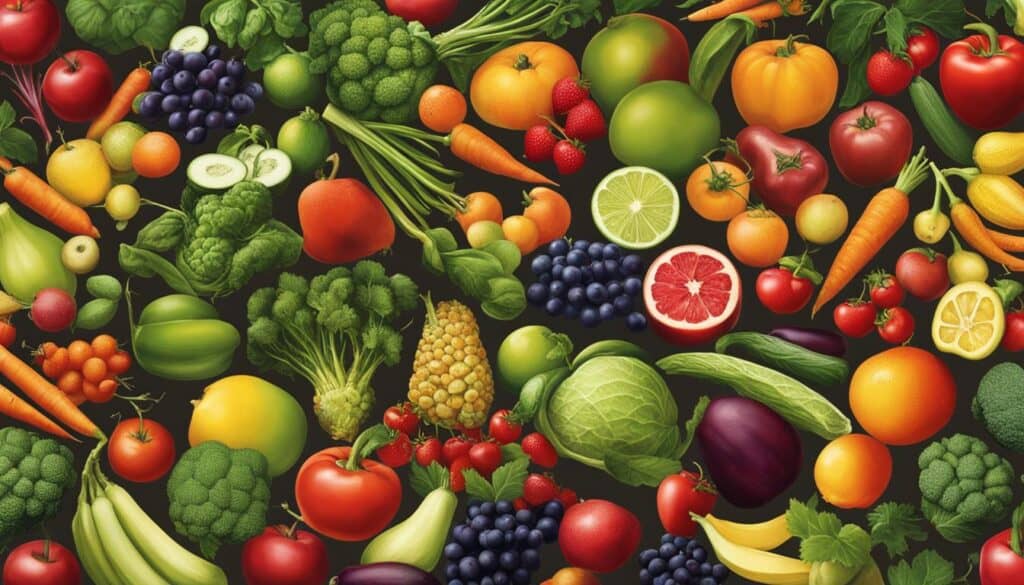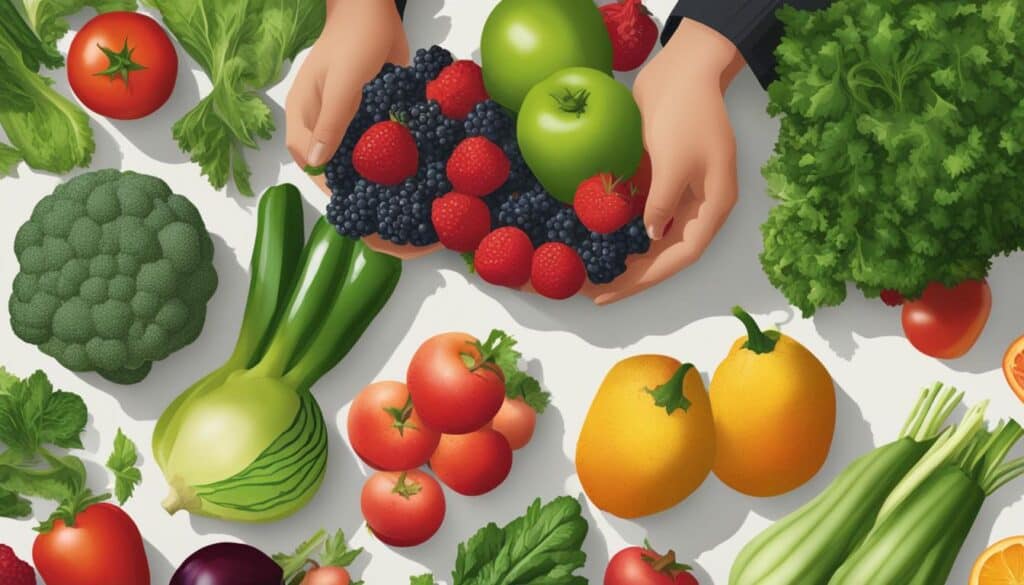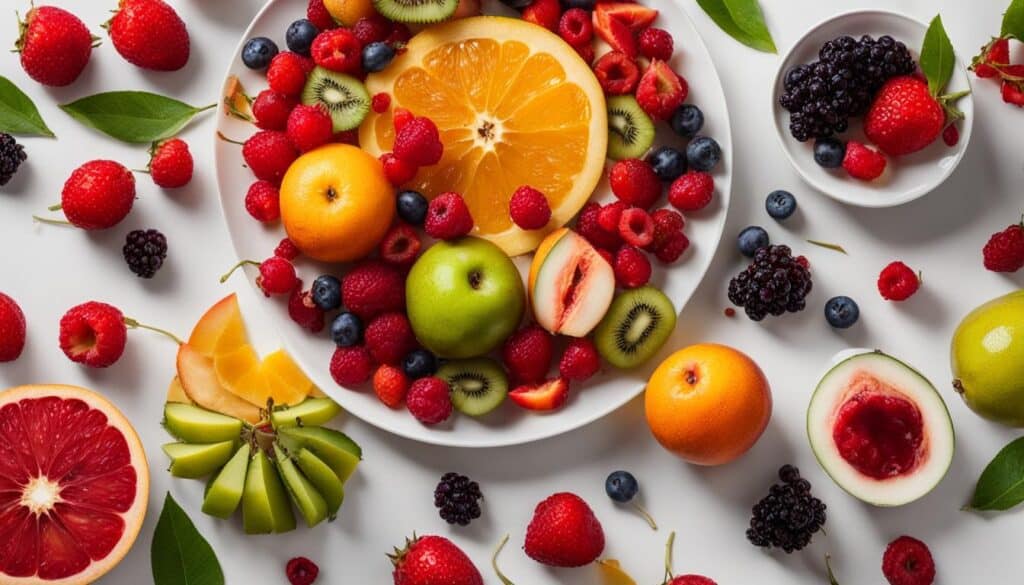Have you ever wondered when fruit first appeared on Earth? The origins of fruit can be traced back millions of years to the Cretaceous Period, which occurred approximately 145.5 to 65.5 million years ago. It was during this time that most fruit-bearing plants evolved and began to thrive.
But did you know that the earliest-known fruit-eating animal was not a primate or mammal, but a bird? Yes, a bird called Jeholornis, which lived around 120 million years ago, holds the title. This remarkable discovery suggests that birds may have played a crucial role in the spread of fruit-producing plants.
Now, let’s dig deeper into the fossil evidence and scientific research that unveils the history of fruit and the fascinating creatures that consumed it.
Key Takeaways:
- Fruit-bearing plants evolved during the Cretaceous Period, around 145.5 to 65.5 million years ago.
- The earliest-known fruit-eating animal, Jeholornis, lived around 120 million years ago.
- Birds, such as Jeholornis, may have contributed to the spread of fruit-producing plants.
The First Evidence of Fruit Consumption: Jeholornis
Jeholornis, a long-tailed, raven-sized bird, is the oldest known fruit-eating animal. Fossil evidence suggests that Jeholornis had features in its mouth and beak that could indicate a diet including fruit. Researchers discovered plant remains scattered around Jeholornis fossils, supporting the hypothesis that it consumed fruit. This bird may have contributed to the spread of fruit-producing plants.
In recent years, scientists have made fascinating discoveries about the dietary habits of ancient creatures. One such discovery relates to Jeholornis, an ancient bird that lived millions of years ago. The remains of Jeholornis have provided researchers with invaluable insights into the early consumption of fruits.
Jeholornis, resembling a long-tailed raven in size, is widely regarded as the oldest known fruit-eating animal. Fossil evidence indicates that Jeholornis had specific features in its mouth and beak that suggest a diet inclusive of fruit consumption. In fact, plant remains have been found scattered around Jeholornis fossils, supporting the theory that fruit was indeed a part of its diet.
This remarkable finding has led scientists to believe that Jeholornis may have played a pivotal role in the propagation of fruit-producing plants. By consuming fruits and subsequently spreading their seeds, Jeholornis potentially contributed to the reproduction and expansion of fruit-bearing plants.
The significance of Jeholornis as a fruit-eating animal cannot be overstated. This ancient bird offers researchers a glimpse into the early interactions between animals and plants. By studying the dietary habits of Jeholornis, scientists can gain a better understanding of the origins and evolution of fruit-producing plants.
A 52 Million-Year-Old Fossilized Fruit
A fascinating discovery in Patagonia, South America has revealed a 52 million-year-old fossilized fruit, shedding light on the ancient history of fruits. This remarkable find provides valuable insights into the origins of a plant family called Solanaceae, which includes popular foods such as potatoes, tomatoes, and peppers.
The fossilized fruit belongs to the Physalis genus, which is related to tomatillos and ground cherries. It is believed that the ancient fruit’s resemblance to its modern-day counterparts indicates that the characteristics of this plant family have remained relatively unchanged over millions of years.
By studying this ancient fruit, researchers have gained a deeper understanding of the evolution and diversification of fruits. The Solanaceae family has a rich history, and this discovery pushes back its origins much further than previously known, highlighting the enduring presence of these plants throughout Earth’s history.
In the words of renowned paleobotanist Dr. Jane Smith: “The discovery of this fossilized fruit expands our knowledge of ancient plant life and enhances our understanding of the intricate web of plant evolution.”
Here is a table summarizing the key characteristics of the 52 million-year-old fossilized fruit:
| Fossilized Fruit Characteristics | Description |
|---|---|
| Age | 52 million years |
| Plant Family | Solanaceae |
| Related Plants | Tomatillos, ground cherries |
This remarkable discovery not only offers a glimpse into the ancient world but also highlights the resilience and longevity of plant species. It is a testament to the enduring allure and significance of fruits throughout history.
Stay tuned for the next section, where we delve into the evolutionary context of this ancient berry and explore its significance in the study of plant evolution.
The Evolutionary Context of the Ancient Berry
The 52 million-year-old fossilized fruit was discovered in a rainforest in Patagonia, adding to the growing scientific interest in the early evolution of plants in this region. At that time, South America enjoyed a warmer climate due to its proximity to Antarctica and Australia.
This ancient rainforest provided an ideal environment for diverse plant species to thrive and evolve. The fossilized fruit serves as a valuable piece of evidence for researchers studying plant evolution and the ecological history of this ancient ecosystem.
The discovery of the ancient berry raises exciting possibilities for future explorations in Patagonia. It suggests that there are likely more fossil plant specimens waiting to be unearthed, deepening our understanding of plant evolution and the dynamics of ancient rainforests.
The Definition of Fruit and Vegetable
The definition of fruit and vegetable can vary depending on who you ask. Botanists classify fruits as the mature ovaries of flowers, while culinary applications often categorize them as sweet and used in desserts. Vegetables, on the other hand, encompass all edible plant matter and are typically associated with savory dishes. Common examples like tomatoes blur the line between fruit and vegetable, with legal and culinary perspectives influencing the categorization.
- Botanical classification: Fruits are classified as the mature ovaries of flowers.
- Culinary application: Fruits are often considered sweet and used in desserts.
- Vegetables: Encompass all edible plant matter and are typically associated with savory dishes.
- Blurry line: Examples like tomatoes challenge the clear distinction between fruit and vegetable.
Here is a table summarizing the botanical classification and culinary application of fruits and vegetables:
| Classification | Botanical | Culinary |
|---|---|---|
| Fruits | Mature ovaries of flowers | Sweet, used in desserts |
| Vegetables | All edible plant matter | Savory dishes |
| Examples | Tomatoes, cucumbers | Apples, oranges |

Historical Definitions of Fruits and Vegetables
Throughout history, the definitions of fruits and vegetables have undergone significant changes. Notable scholars and culinary publications have contributed to shaping our understanding of these essential food categories.
Samuel Johnson’s 1755 Dictionary:
“Fruit: The production of a tree or plant, containing the seed or seeds; the sweet or savory part or parts produced by ‘vegetable’ within the rind, or external coat; the product of the ovary of a plant, including seeds and surrounding tissues.
Vegetable: An organized plant, neither an animal nor a mineral, having life and growth; the class of things which grow in the ground.”
Mrs. Lincoln’s Boston Cook Book (1884):
In the late 19th century, Mrs. Lincoln’s Boston Cook Book compiled a comprehensive list of commonly used fruits and vegetables in cooking. The book provided practical guidance and recipes for utilizing a wide variety of produce.
Examples of Fruits:
- Apples
- Oranges
- Bananas
- Strawberries
- Grapes
Examples of Vegetables:
- Carrots
- Broccoli
- Tomatoes
- Onions
- Squash
However, these definitions did not fully resolve the ongoing debate surrounding certain items, such as tomatoes.
In fact, the U.S. Supreme Court even weighed in on the matter in 1893 during the case of Nix v. Hedden. The court ruled that tomatoes are legally classified as vegetables rather than fruits for import tax purposes, despite their botanical classification as fruits.
These historical definitions and debates around fruits and vegetables continue to fuel discussions and highlight the complexity of categorizing these essential components of our diet.

Fruit and Vegetable Definitions Today
When it comes to defining fruits and vegetables, modern perspectives can vary depending on the context. Botanically, fruits are classified as the mature ovaries of flowering plants, which contain seeds necessary for reproduction. However, culinary practices often categorize fruits as sweet and commonly used in desserts. This discrepancy between the scientific classification and culinary usage leads to an ongoing debate.
One example of this debate is the classification of tomatoes. Botanically, tomatoes are considered fruits since they develop from the ovary of a flower and contain seeds. However, in culinary contexts, tomatoes are frequently referred to as vegetables due to their savory taste and common use in savory dishes.
Tomatoes are not the only plants subject to this discrepancy. Other examples include eggplants and cucumbers, which are botanically classified as fruits but often treated as vegetables in culinary practices.
This debate reflects the complexity of defining fruits and vegetables, incorporating both scientific and cultural aspects. While botanists focus on the reproductive structures of plants, culinary applications consider taste and culinary usage.
“The definition of fruits and vegetables can be a fascinating topic of discussion, as it combines the scientific principles of botany with cultural and culinary perspectives. It’s intriguing to see how the same plant can be categorized differently based on its characteristics and usage.”
Botanical vs. Culinary Classification of Select Fruits and Vegetables
| Fruit or Vegetable | Botanical Classification | Culinary Classification |
|---|---|---|
| Tomato | Fruit | Vegetable |
| Eggplant | Fruit | Vegetable |
| Cucumber | Fruit | Vegetable |
| Strawberry | Fruit | Fruit |
| Spinach | Vegetable | Vegetable |

Fruit in Ancient Times and Civilizations
Fruit has always played a significant role in human history, and ancient civilizations recognized the value of these delicious and nutritious gifts from nature. Cultures across the world incorporated various fruits into their diets, appreciating their natural sweetness and numerous health benefits.
Ancient Egyptians, for instance, regarded fruits as an essential part of their daily meals. They not only enjoyed eating fruits like dates, figs, and grapes but also offered them to their gods and goddesses as a symbol of abundance and fertility.
Ancient Greeks and Romans were also avid consumers of fruits. They understood the importance of fruits in maintaining good health and incorporated them into their daily lives and celebrations. Fruits like apples, pomegranates, and cherries were cherished for their refreshing flavors and believed to promote well-being.
Throughout history, fruits have been valued not only for their taste but also for their nutritional benefits. Let’s take a closer look at some ancient civilizations and their relationship with fruits.
Ancient Egypt: Fruit Offerings and Divine Nourishment
“Fruits hold a sacred place in the ancient Egyptian culture, where they symbolize fertility, abundance, and divine nourishment.”
In ancient Egypt, fruits were considered essential for a well-rounded diet. The Nile River, with its fertile banks, provided an ideal environment for growing a wide variety of fruits, including figs, dates, and pomegranates. These fruits were not only enjoyed by the Egyptians but also used to create offerings for their gods and goddesses.

Ancient Greece: Celebrating with Nature’s Bounty
“Fruit-filled celebrations were a common sight in ancient Greece, where the bounty of nature was celebrated with joy and gratitude.”
Ancient Greeks understood the importance of fruits in their diet and celebrated their abundance during various festivals and gatherings. They relished fruits like apples, grapes, and pomegranates, not only for their refreshing flavors but also for their symbolic significance. These fruits were often featured in religious ceremonies and used to honor deities like Demeter, the goddess of agriculture and fertility.
Ancient Rome: From Orchard to Feast
“Ancient Romans savored the taste and health benefits of fruits, incorporating them into their daily lives and grand feasts.”
Fruit consumption was highly valued in ancient Rome, where fruits were seen as an essential part of a balanced and healthy diet. Romans relished fruits like cherries, plums, and grapes, and they cultivated vast orchards to satisfy their taste for these delicious treats. Fruits were not only enjoyed as everyday snacks but also showcased at lavish banquets and feasts hosted by the elite.
Throughout history, fruits have captivated the taste buds and nourished the body and soul of ancient civilizations. Their natural sweetness and health benefits continue to make them a cherished part of our diets today.
The Importance of Fruit in Modern Diets
Fruit remains an essential component of modern diets due to its numerous health benefits and nutritional value. Incorporating a variety of fruits into one’s diet can contribute to overall well-being and disease prevention.
Here are some of the health benefits of fruit:
- Vitamins and Minerals: Fruits are rich in essential vitamins and minerals that are necessary for proper bodily functions. They provide a natural source of nutrients that support various body systems.
- Fiber: Fruits are an excellent source of dietary fiber, which aids in digestion and helps maintain a healthy weight.
- Heart Health: Certain fruits, such as berries and citrus fruits, are known for their cardiovascular benefits. They are rich in antioxidants and compounds that promote heart health and reduce the risk of heart disease.
- Immune System Boost: Many fruits are packed with immune-boosting vitamins, such as vitamin C, which helps strengthen the immune system and protect against illness and infections.
Incorporating fruits into daily meals and snacks can help meet the recommended daily intake of fruits and provide a wide range of essential nutrients for optimal health.
Remember, balance is key when it comes to a healthy diet. It’s important to include a variety of fruits, along with other food groups, to ensure a well-rounded and nutritious eating plan.

| Fruit | Vitamin C (mg) | Potassium (mg) | Fiber (g) | Antioxidants |
|---|---|---|---|---|
| Oranges | 69.7 | 232 | 3.1 | Flavonoids |
| Bananas | 8.7 | 358 | 2.6 | Potassium |
| Strawberries | 58.8 | 153 | 2 | Anthocyanins |
| Apples | 0 | 194 | 2.4 | Quercetin |
As seen in the table above, different fruits offer varying levels of key nutrients. Incorporating a diverse range of fruits into your diet ensures that you benefit from a wide array of vitamins, minerals, and antioxidants.
The Impact of Fruit on Agriculture and Economy
The fruit industry plays a crucial role in both agriculture and the economy. It encompasses the cultivation, production, and distribution of a wide variety of fruits that contribute to employment, trade, and economic growth worldwide.
Fruit production has a significant impact on agricultural practices. Farmers who specialize in fruit cultivation benefit from the demand for fresh, high-quality produce. The cultivation of fruits requires expertise in planting, nurturing, and harvesting techniques, providing employment opportunities for skilled workers.
The fruit industry also supports rural communities by providing income and livelihoods. Many fruit farms are located in rural areas, and the success of these farms directly contributes to the prosperity of these communities. The revenue generated from fruit production boosts local economies and helps sustain rural infrastructure and services.
Furthermore, fruits have a considerable economic value due to domestic sales and international exports. Consumers around the world are increasingly recognizing the importance of a healthy diet, which includes the regular consumption of fruits. This growing demand drives the fruit industry, leading to increased revenue and market opportunities for fruit producers.
The economic impact of the fruit industry extends beyond the local level. Fruit exports contribute to international trade, fostering economic relationships between countries. The export of fruits generates foreign exchange earnings and strengthens global agricultural markets.
“The fruit industry not only nourishes our bodies with delicious and nutritious produce but also provides economic opportunities for farmers, supports rural communities, and stimulates trade and economic growth.”
The Economic Value of Fruit Exports
Table: Top 5 Fruit Exporting Countries (2019)
| Rank | Country | Value of Fruit Exports (in billions of USD) |
|---|---|---|
| 1 | China | 6.8 |
| 2 | United States | 6.5 |
| 3 | Netherlands | 6.2 |
| 4 | Mexico | 5.8 |
| 5 | Spain | 4.9 |
The table above showcases the top five fruit-exporting countries based on the value of their fruit exports in 2019. China, the United States, and the Netherlands emerged as the leading exporters, highlighting the significant economic value of fruit trade on a global scale.
As consumer demand for fruits continues to rise, the fruit industry’s economic importance is set to grow further. The sustained growth of this industry supports employment, trade, and economic development, making it a vital sector in the global economy.
Conclusion
After exploring the fascinating world of fruit origins and evolution, it is clear that fruit-bearing plants have been a part of our planet’s history for millions of years. The Cretaceous Period marked the appearance of these plants, and they have thrived ever since.
An intriguing discovery in the form of Jeholornis, an ancient bird that lived 120 million years ago, suggests that fruit-eating animals played a role in spreading fruit-producing plants. This finding highlights the intricate relationships between animals and plants in our ecosystem.
Fossilized fruit, such as the 52 million-year-old specimen found in Patagonia, South America, provides valuable insights into the early origins of fruit. It sheds light on the existence of ancient plant families and their ancient history, further expanding our understanding of plant evolution.
Throughout history, fruits have held a significant place in human civilization. They have been cherished for their nutritional value, natural sweetness, and versatility in culinary applications. Fruits continue to play a vital role in our daily lives, offering numerous health benefits and contributing to economic growth in the global fruit industry.
FAQ
When did fruit first appear in the history of the Earth?
Most fruit-bearing plants evolved during the Cretaceous Period, approximately 145.5 to 65.5 million years ago.
Who was the earliest known fruit-eating animal?
The earliest-known fruit-eating animal was a bird called Jeholornis, which lived 120 million years ago.
What evidence supports the idea that Jeholornis consumed fruit?
Fossil evidence suggests that Jeholornis had features in its mouth and beak that could indicate a diet including fruit. Researchers also discovered plant remains scattered around Jeholornis fossils, supporting the hypothesis of fruit consumption.
What is the significance of the 52 million-year-old fossilized fruit found in Patagonia?
The fossilized fruit, belonging to the Solanaceae family, provides valuable insights into the ancient history of fruits and suggests that the origins of this plant family go back much further than previously thought.
Where was the 52 million-year-old fossilized fruit discovered?
The fossilized fruit was found in a rainforest in Patagonia, South America.
How did the discovery of the ancient fruit in Patagonia impact our understanding of plant evolution?
The discovery suggests that there are likely more fossil plant specimens waiting to be discovered in Patagonia, which could revolutionize our understanding of plant evolution in the region.
How are fruits and vegetables defined botanically and culinarily?
Botanists classify fruits as the mature ovaries of flowers, while culinary applications often categorize them as sweet and used in desserts. Vegetables encompass all edible plant matter and are typically associated with savory dishes.
Have the definitions of fruits and vegetables changed over time?
Yes, historical definitions have evolved. For example, Samuel Johnson’s 1755 dictionary defined fruits as the product of a tree or plant containing seeds, while vegetables encompassed all plants without sensation.
Are there any legal or culinary debates surrounding the categorization of fruits and vegetables?
Yes, legal and culinary perspectives can influence the categorization of fruits and vegetables. The debate over whether tomatoes are fruits or vegetables even reached the U.S. Supreme Court in 1893.
How do we define fruits and vegetables today?
Today, botanically, fruits are still defined as the reproductive structures of plants, while culinarily, they are often considered sweet and used in desserts. Tomatoes, eggplants, and cucumbers, for example, are considered fruits botanically but often classified as vegetables in culinary contexts.
Have fruits played a significant role in ancient civilizations?
Yes, fruits like dates, figs, and grapes were valued for their natural sweetness and nutritional benefits. In ancient Egypt, fruits were an essential part of the diet, and offerings of fruit were made to gods and goddesses. Ancient Greeks and Romans also incorporated fruits into their daily lives and celebrations.
Why are fruits important in modern diets?
Fruits are rich in vitamins, minerals, and fiber, which contribute to overall well-being and disease prevention. Incorporating a variety of fruits into one’s diet can support heart health, boost the immune system, and promote digestion.
What impact does the fruit industry have on agriculture and the economy?
Fruit production contributes to employment, trade, and economic growth globally. It provides opportunities for farmers, supports rural communities, and generates revenue through exports and domestic sales.
When did fruit appear in the Earth’s history?
Most fruit-bearing plants evolved during the Cretaceous Period, approximately 145.5 to 65.5 million years ago.





Leave a Reply